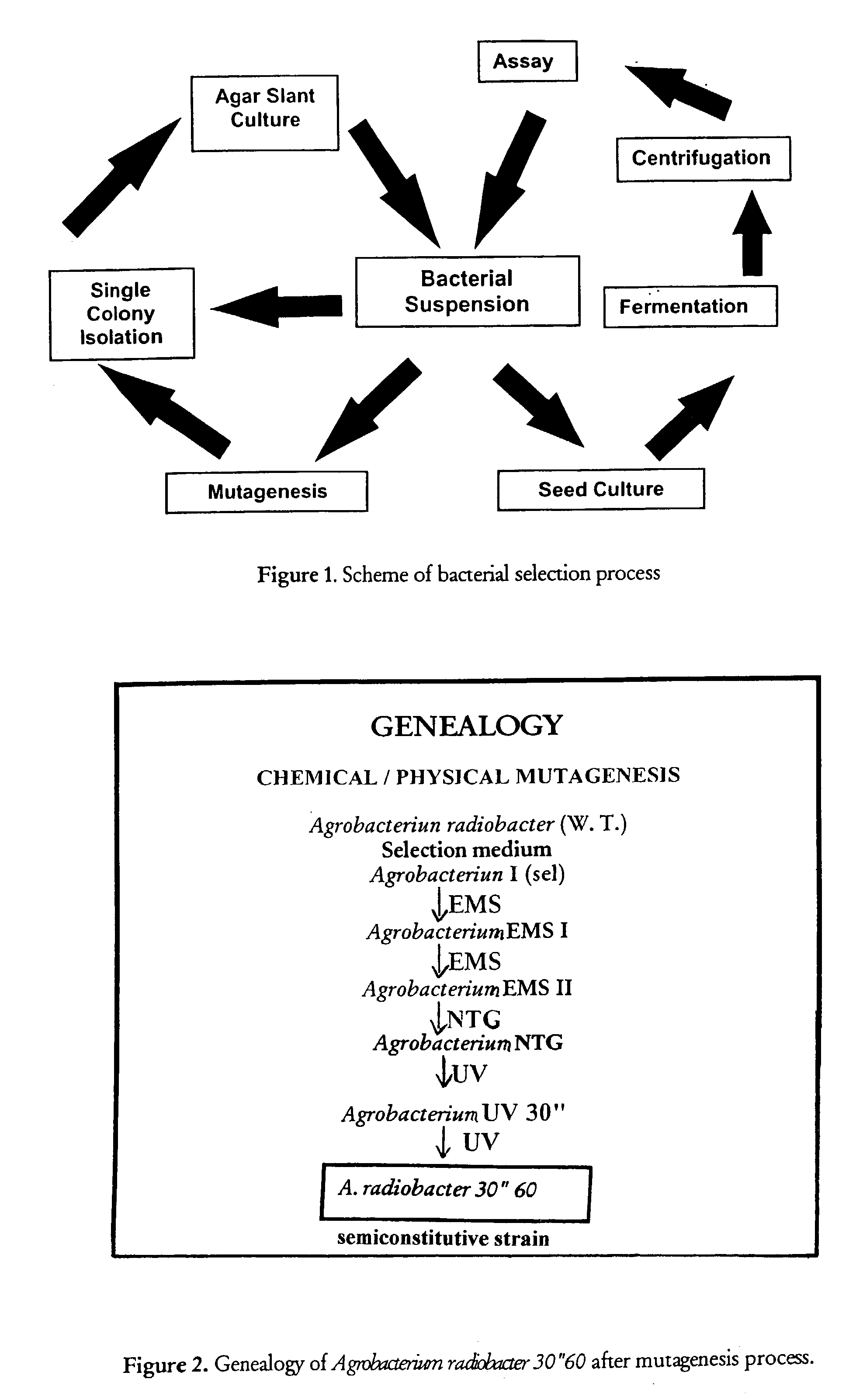Micro-organism possessing enantioselective and regioselective nitrile hydratase/amidase activities
a technology of nitrile hydratase and amidase, which is applied in the direction of sugar derivatives, biochemistry apparatus and processes, enzymes, etc., can solve the problem of lacking amidase activity
- Summary
- Abstract
- Description
- Claims
- Application Information
AI Technical Summary
Benefits of technology
Problems solved by technology
Method used
Image
Examples
example 1
Mutagenesis of the Parent Strain
[0077] The parent strain, characterised as Agrobacterium radiobacter, was isolated from a crude bacterial extract with antibiotic activity. In order to determine activity towards nitrilic substrates, it was sub-cultured in medium containing butyronitrile and after some passages and induction with valeronitrile, a weak nitrile-hydratase / amidase activity was measured on benzoylphenylpropionitrile (BPN) of the wild type strain as such selected. To obtain a semi-constitutive strain, an aliquot of wild type parent strain was subjected to a treatment of mutagenesis, constituted by two treatment cycles with ethylmethanesulphonate, one cycle with nitrosoguanidine and two of mutagenesis with UV irradiation.
[0078] At each stage of mutagenesis, an aliquot of the culture was assayed for the nitrile conversion activity (FIG. 1).
[0079] The mutagenesis protocols were adapted to Agrobacterium radiobacter from Ausubel, F. M. et al. "Current Protocols in Molecular Biol...
example 2
Characterisation of the Semi-constitutive Strain Agrobacterium radiobacter 30"60 n.degree. 41108
[0089] The characteristics relating to the isolated strain are summarised in table 1 and are hereby further briefly commented as follows.
[0090] Morphological Characteristics
[0091] The strain Agrobacterium radiobacter 30"60 is present as a rod of approx. 0.8 .mu.m by 1.5-3 .mu.m. Under the microscope it appears mobile, does not form spores and is Gram-negative after appropriate staining. Starting from lyophilised strain, after 48 hours of growth on solid medium (seed-agar) the strain forms rough, rounded colonies, of 1.2 mm in diameter and of ivory / white colour.
[0092] Culture and growth properties. The strain represents an obligatory aerobe and does not reduce nitrates. It is oxidase negative and catalase positive, contrary to the parental strain. The strain grows at a pH comprised of between 6-9 and at a temperature comprised of between 5 and 45.degree. C. It does not produce acid from: g...
example 3
Preparation of the Bacterial Biocatalyst of the Mutagenised Strain NCIMB 41108
[0094] The enzymatic activity was evaluated using a bacterial pellet obtained after fermentation for 48 hours in fermentation medium as described below. Briefly, the culture was amplified from a single colony to begin with in a small volume of inoculating medium and then, for preparative purposes, in 100 ml of fermentation medium.
[0095] Inoculating medium: peptone 10 g / L, yeast extract 10 g / L, NaCl 5 g / L, glucose 5 g / L. The pH of the medium was adjusted to pH 7.2 with NaOH and sterilised.
[0096] Fermentation medium: MgSO.sub.4 (0.5 g l.sup.-1), ,CaCl.sub.2.6H.sub.2O (0.1 g l.sup.-1), FeSO.sub.4 (0.4 g l.sup.-1), CoCl.sub.2 (0.1 g l.sup.-1), MnSO.sub.4 (0.01 g l.sup.-1), (NH.sub.4).sub.2SO.sub.4 (5 g l.sup.-1), Yeast Extract (10 g l.sup.31 1). The inducer, or the inducers, were added to the fermentation medium alone or in combination, sterilely, to a final concentration comprised of between 0.5-5 g / L. In par...
PUM
| Property | Measurement | Unit |
|---|---|---|
| Angle | aaaaa | aaaaa |
| Angle | aaaaa | aaaaa |
| Angle | aaaaa | aaaaa |
Abstract
Description
Claims
Application Information
 Login to View More
Login to View More - R&D
- Intellectual Property
- Life Sciences
- Materials
- Tech Scout
- Unparalleled Data Quality
- Higher Quality Content
- 60% Fewer Hallucinations
Browse by: Latest US Patents, China's latest patents, Technical Efficacy Thesaurus, Application Domain, Technology Topic, Popular Technical Reports.
© 2025 PatSnap. All rights reserved.Legal|Privacy policy|Modern Slavery Act Transparency Statement|Sitemap|About US| Contact US: help@patsnap.com

